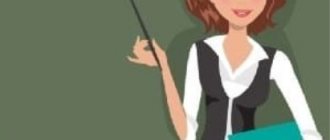Battle of Moscow. Conversation for children
A conversation about the Great Patriotic War for children 6-9 years old on the topic “The defeat of fascist troops near Moscow.”
Summer flew by.
Autumn has come; But Muscovites were not pleased with the blue of the high Heavens, the gold of the foliage - After all, the Germans were close to Moscow. During the first months of the war, luck favored the German troops. After all, they attacked us unexpectedly, were well armed and forced the population of the conquered countries of Europe to work for them. In the fall of 1941, the Nazis came close to Moscow. Hitler wanted to capture our capital and then flood it, so that not only no trace, but even memories would remain of Moscow! On October 20, a state of siege was declared in Moscow. Children, women and old people began to be taken out of the capital. Residents who remained in the city began to build barricades, fortifications, and dig barriers and ditches around it. Meanwhile, German aircraft bombed the city. Fires were caused by incendiary bombs. Muscovites were on duty on the roofs of houses, extinguishing bombs in boxes of sand. At night, Moscow plunged into complete darkness. The lights in the apartments were not turned on so as not to attract the enemy, the glass in the frames was sealed with paper crosswise so that they would not be destroyed by the blast wave. The life of Muscovites in those days was difficult and alarming. There was no heat in the houses, bread was given out on ration cards, because most of the food was sent to the front. When German troops came close to Moscow, and the situation at the front became critical, the command of the army was entrusted to the most talented commander, a brave and determined man, Georgy Konstantinovich Zhukov. Hot battles broke out near Moscow. The soldiers fought for every piece of land. An army fought in the Volokolamsk direction under the command of General Konstantin Konstantinovich Rokossovsky. “The Nazis brought into battle strong groups of 30-50 tanks, accompanied by dense chains of infantry, supported by artillery fire and bombers from the air,” K.K. later recalled. Rokossovsky. So it was not easy to deal with the enemy! “Russia is great, but there is nowhere to retreat—Moscow is behind us!” - these words became a symbol of the battle for Moscow. Look at the poster “Let's Defend Moscow!”
In the Tver region, German troops met powerful resistance from the Red Army.
They were running out of shells, grenades, Molotov cocktails... But the Red Army soldiers launched a bayonet attack! It was so stormy and furious that the Germans could not stand it and fled in panic. The city of Tula held firm on the southwestern approaches to Moscow. Our air force played a very important role in protecting the capital. Air defense made the city almost impregnable, holding back enemy attacks. Eight thousand fascist planes circled in the skies over Moscow to drop bombs. The Red Army pilots showed miracles of courage: they shot down and destroyed 1,392 enemy aircraft. It was during these days that pilot Viktor Talalikhin made his first night ram. Nikolai Gastello sent his burning plane into a column of German troops and died, destroying hundreds of German soldiers and officers. At the beginning of November, the German offensive was stopped, and the enemy was driven back from Moscow! Dear Guys! Imagine that where Moscow streets, parks, squares and squares are now, 60 years ago there were anti-tank barriers, deep dark trenches, ditches, and trenches. The line of defense of the capital passed here. Thousands of soldiers gave their lives defending Moscow. Perhaps your grandfathers were among them! They defended the capital.
The capital's beautiful quarters. We don’t recognize Moscow today! But the Fascist dark army once stood nearby. Crows circled over the field. The flying forest turned yellow, And the line of defense of Moscow passed here. Funnels, trenches, trenches. Explosions of mines and grenades - Here, without sparing their lives, hundreds of soldiers died. They defended the capital, And we will not forget them, We will be proud of the feat of our fearless grandfathers! So, through the heroic efforts of the Red Army soldiers, the German offensive near Moscow was stopped.
In the Battle of Moscow, for the first time during World War II, the Nazis received a powerful, unexpected rebuff. Our soldiers, with their dedication and fearlessness in battle, dispelled the myth of the invincibility of the enemy. The Germans did not want to believe in their defeat! They tried to explain it by the onset of cold autumn, torrential rains, and mud on the roads, which made it difficult for soldiers and equipment to move around. “It became impossible to move on the roads, the mud stuck to the legs, hooves of animals, and car wheels. Even the so-called highways have become impassable. The advance stopped. The Russians bought time to improve their defenses, replenish their troops and increase their reserves,” one of his generals reported to Hitler. Another German general—G. Blumentritt explained the defeat of the German troops near Moscow more honestly: “When we came close to Moscow, the mood of our commanders and troops changed dramatically. We discovered with surprise and disappointment in October and early November that the defeated Russians had not ceased to exist as a military force. Over the past weeks, enemy resistance has intensified, and the tension of the fighting increased every day.” In November 1941, the Nazi command decided to make a second attempt to capture Moscow. Using the example of Poland, France and other European countries, the German command was convinced that after the capture of the capital of the state, resistance in them ended. And if Moscow holds out, it will undermine the morale of German soldiers, and a bleak future awaits Nazi Germany. “It was clear to every soldier of the German army that our life or death depended on the outcome of the battle for Moscow,” wrote the German general. For the second attack on Moscow, the German command brought ten fresh divisions to the city. On November 15, on a frosty, clear morning, the Nazis again moved towards our capital. They wanted to surround it from the north and south. Stubborn fighting broke out in the Volokolamsk area. The date November 16, 1941 went down in the history of the Great Patriotic War as the day of an unforgettable feat performed by our soldiers in the area of the Dubosekovo crossing. 28 Red Army soldiers under the command of General Ivan Vasilyevich Panfilov knocked out 14 German tanks with grenades, Molotov cocktails and fire from anti-tank rifles! The Nazi advance was stopped again. The first shock army operated in the area of the city of Klin; near Zvenigorod, German troops were defeated by the army of General Leonid Aleksandrovich Govorov, and near Tula they were driven back by the cavalry corps of General Pavel Alekseevich Belov. In December 1941 it was bitterly cold and there was deep snow everywhere. Hitler's troops were poorly equipped and had neither warm sheepskin coats nor comfortable shoes. The Germans were not prepared to wage war in winter conditions, because they were counting on a quick victory, which they did not succeed. The Red Army drove the Germans back from Moscow! In the fiercest battles near Moscow, we survived and won! But this victory came at a high price. Everywhere near Moscow there are monuments to fallen soldiers: in Podolsk, Lobnya, Yakhroma, Dubosekovo, Kryukovo, Volokolamsk, Istra... This is the memory of those who gave their lives heroically fighting for their Motherland! Answer the questions - When did the Nazis first approach Moscow? — How did Muscovites prepare for the defense of the city? — How and where did the battles for Moscow take place? — Why were the Germans defeated in the Battle of Moscow? — Tell us about the feat of the Panfilov heroes. — In which cities near Moscow are monuments to fallen soldiers erected? Author: T.A. Shorygina
We recommend watching:
A conversation about the beginning of the war for junior schoolchildren. The Belarusian operation. Liberation of Belarus and the Baltic states Conversation about the Battle of Stalingrad for younger schoolchildren Conversation “The Battle of Kursk” for 4th grade
Similar articles:
About the heroes of the Great Patriotic War of 1941-1945. for children 3-4 grades
Lesson of courage “Battle for Moscow”
A lesson in courage on the topic “Battle for Moscow”
Explanatory note.
Goals and objectives of the event:
-moral and patriotic education of schoolchildren,
-attracting the attention of the younger generation to the heroic pages of the history of their homeland,
- forming in children pride in their Motherland, its people and military glory.
Scope of application: conducting a class hour dedicated to the anniversary of the Victory.
Forms and methods of implementation: story-conversation accompanied by a presentation
Necessary logistics: presentation made in MS Power Point, multimedia equipment.
Respect for your country, its history, traditions and rich culture is the basis of any education. That is why the civic and patriotic education of junior schoolchildren is one of the most important areas in the work of a primary school teacher. It is this that should become the unifying force that can raise a generation of true patriots who love their Motherland not in words, but in deeds.
Patriotism is pride in the achievements of one’s native country, bitterness for its failures and defeats, interest and respect for its historical past.
A huge role in solving these problems is played by turning to the themes of the Great Patriotic War of 1941-1945. During this difficult period, the best traits of the people emerged, and victory in the war was the result of courage, heroism, and perseverance of the Soviet people.
The Battle of Moscow is one of the decisive battles of the Great Patriotic War. This was the first major victory of Soviet troops over
Nazi Germany, the myth of the “invincibility” of the German army was dispelled, and the spirit of the Soviet people was raised in the fight against the enemy.
One of the main tasks of considering the Moscow Battle should be to reveal the great feat of the defenders of our capital. It is important that children understand the enormous danger that fascism brought to the entire country, to all of humanity.
One of the significant aspects of the topic is the disclosure of the thesis: “Moscow was defended by the whole country, Moscow defended the whole country.” Students must be shown that victory near Moscow is a victory for the entire people: soldiers, generals and those who selflessly worked in the rear.
In order to connect ideas about those distant events with the direct spiritual experience of younger schoolchildren, a week before
during the class hour, students were asked to talk with relatives about how their families lived during the war; find out whether any of the family members participated in the defense of Moscow.
During the presentation, the children were asked questions to clarify their correct understanding of what they heard. For example:
— Why do you think the Nazis sought to conquer Moscow?
-Why were anti-tank hedgehogs placed on the streets of Moscow?
-How do you understand V. Klochkov’s words?
-Which song is sung about Panfilov’s heroes?
-For what purpose was the parade held on Red Square on November 7, 1941?
-Why didn’t the fascist troops manage to capture Moscow? etc.
It is very important when holding such an event to create an appropriate emotional background. For this purpose, fragments of recordings of music and songs from the war years were used.
The creative task prepared by students for the class hour also became emotionally significant. The guys composed and designed “Letters from the 21st Century” addressed to the defenders of Moscow. Modern schoolchildren very touchingly and sincerely thanked the fallen heroes and veterans who have lived to this day, for the clear sky above their heads, for their happy, peaceful childhood. Thanks to this bright moment, the class hour dedicated to the Battle of Moscow did not turn into a formal listing of dates, names, facts and events and contributed to the children realizing themselves as part of their hometown and the whole country.
Accompanying text
for the presentation "Battle for Moscow".
2 slide
In 2020, our country celebrated a great date: 75 years since the Victory over Nazi Germany.
Our country has had to experience many wars throughout its history, but the most terrible and longest was the Great Patriotic War.
3-4 slides
On June 22, 1941, the troops of Nazi Germany attacked our Motherland.
The first months of the war were bitter. Our troops retreated, and three months later the fascist troops came close to Moscow. The Nazis were confident of their victory and even developed a plan in advance for the complete destruction of Moscow. The leader of the fascist army, Adolf Hitler, ordered: “The city must be surrounded so that not a single Russian soldier,
not a single inhabitant, be it a man, a woman or a child, could leave it... Where Moscow stands, a huge sea should appear, which will forever hide the capital of the Russian people from the world.”
5 slide
Fortunately, this cruel plan was not allowed to come true! From the very first days of the war, Muscovites began to prepare to defend their city. “Everything for the front, everything for victory!” - that was the motto of those days.
(The first verses of the song “Holy War” are heard)
6-7 slides
Grown men and very young boys and girls enrolled in the ranks of the Red Army and the People's Militia.
8 slide
In the factories, instead of the men who had gone to the front, women and teenagers stood at the machines. They worked 12 hours a day, providing the capital with weapons and ammunition.
Slide 9
Muscovites helped the front in whatever way they could: knitting warm clothes, collecting parcels for soldiers, caring for the wounded in hospitals.
10 slide
Thousands of townspeople, mostly women, despite the cold and rain, built defensive lines, dug trenches, erected barriers and barricades, and carried sandbags. The work was very hard, but no one complained or gave up.
11-13 slides
Anti-tank hedgehogs were installed on the streets and squares of Moscow,
and balloons were placed in the sky to block the path of enemy aircraft.
Slide 14
Raids on Moscow began from the first day of the war. The Nazis dropped thousands of incendiary bombs and land mines on the city. To protect Moscow from bombing, an air defense system was created.
15 slide
Artillery troops were stationed around Moscow and shot down enemy planes as they approached the capital.
16 slide
During the bombing, an air raid alert was announced in the city. People left their apartments for bomb shelters, where they could hide from explosions. Some Moscow metro stations served as such bomb shelters.
Slide 17
But often people, returning to their home, found only ruins in its place...
18-20 slides
Muscovites courageously defended their hometown, but still the main burden of the war fell on the shoulders of the soldiers of our army.
21 slides
Georgy Konstantinovich Zhukov was appointed commander of the front that covered Moscow. The soldiers said “Where Zhukov is, there is victory!”
22-25 slides
On November 7, 1941, a traditional parade took place in the center of Moscow. Despite the fact that the enemy troops were very close to Moscow, rows of soldiers marched along Red Square and straight from the parade the soldiers went to the front.
26 slide
In mid-November, the Nazis made another attempt to attack Moscow. The enemy's plans were to surround the city with tank troops and then capture it.
On one of the fronts, a rifle division under the command of Ivan Vasilyevich Panfilov stood in the way of the Nazis.
Slide 27
At the Dubosekovo crossing, 28 Panfilov soldiers took on the blow of 50 enemy tanks. There, one of the fighters, Vasily Klochkov, uttered the historical words: “Russia is great, but there is nowhere to retreat - Moscow is behind us!”
At a critical moment in the battle, political instructor Klochkov was the first to throw himself under an enemy tank with a bunch of grenades, blow it up and die a hero’s death.
28 slide
This battle lasted only 4 hours. 18 tanks were knocked out by Panfilov’s heroes. Of the 28 soldiers, only 4 survived. But at the cost of the lives of the soldiers, the attack was repulsed, the tanks did not reach Moscow.
Slide 29
A lot of feats like this were accomplished, defending the capital, people spared neither their strength nor even their lives!
And so on December 5th Sov. The army launched a counteroffensive and drove the fascist troops away from Moscow.
30 slide
The German army, which was considered invincible, was on the verge of destruction. The victory in the battle of Moscow showed the whole world that the Nazis can be beaten, which means they can be defeated!
31-32 slides
Our people's confidence in Victory has strengthened!
But before the final defeat of the fascist troops, our soldiers had to fight for another four long years...
Slide 33
After the war, in his book of memoirs G.K. Zhukov wrote:
“When people ask me what I remember most from the last war, I always answer: “The Battle of Moscow.” Expressing deep gratitude to all the survivors of the battle for Moscow, I bow my head to the blessed memory of those who fought to the death, but did not let the enemy into the heart of our Motherland, its capital, the hero city of Moscow. We are all indebted to them!”
Class teacher of grade 9 B: Vinogradsky A. Yu.


